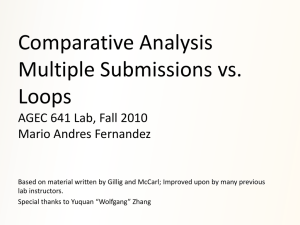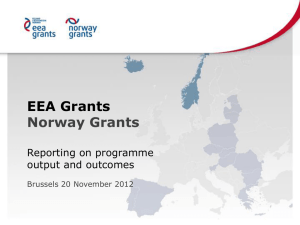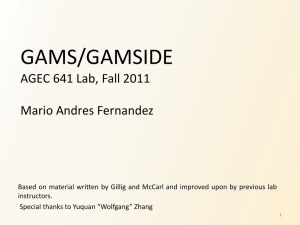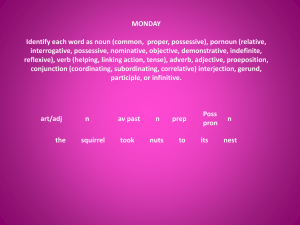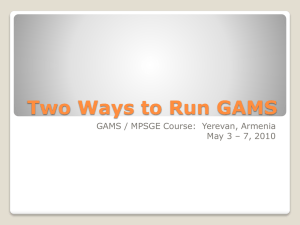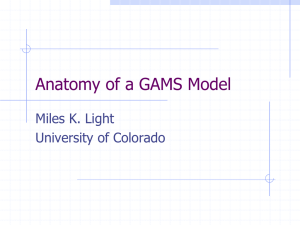GAMS and classifications
advertisement
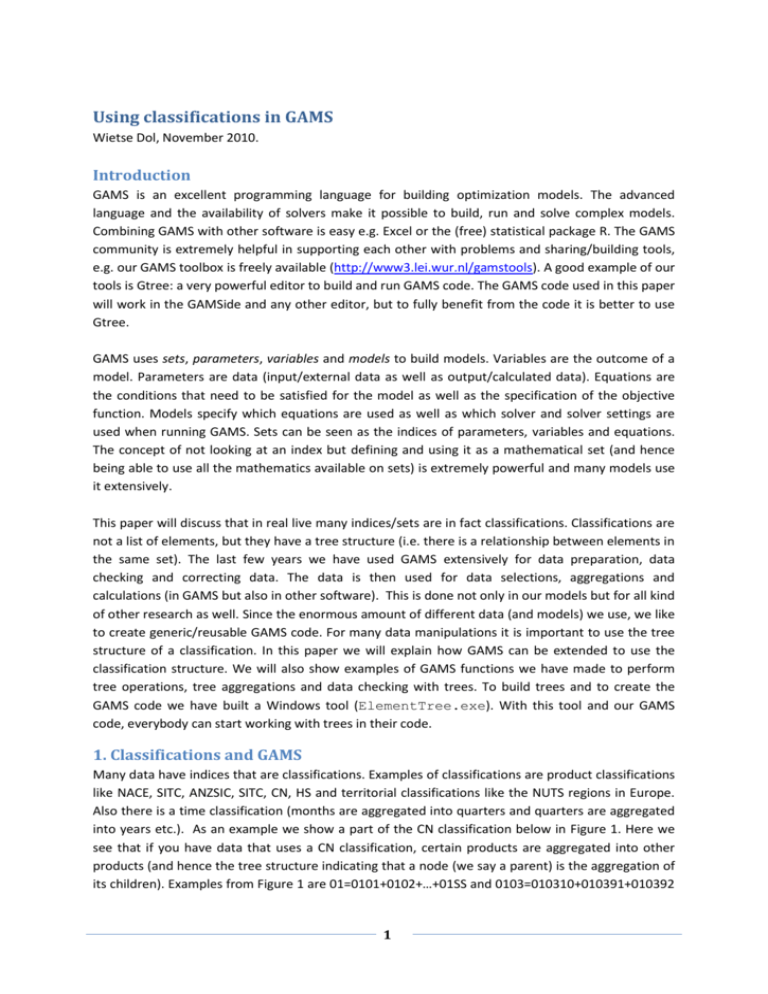
Using classifications in GAMS Wietse Dol, November 2010. Introduction GAMS is an excellent programming language for building optimization models. The advanced language and the availability of solvers make it possible to build, run and solve complex models. Combining GAMS with other software is easy e.g. Excel or the (free) statistical package R. The GAMS community is extremely helpful in supporting each other with problems and sharing/building tools, e.g. our GAMS toolbox is freely available (http://www3.lei.wur.nl/gamstools). A good example of our tools is Gtree: a very powerful editor to build and run GAMS code. The GAMS code used in this paper will work in the GAMSide and any other editor, but to fully benefit from the code it is better to use Gtree. GAMS uses sets, parameters, variables and models to build models. Variables are the outcome of a model. Parameters are data (input/external data as well as output/calculated data). Equations are the conditions that need to be satisfied for the model as well as the specification of the objective function. Models specify which equations are used as well as which solver and solver settings are used when running GAMS. Sets can be seen as the indices of parameters, variables and equations. The concept of not looking at an index but defining and using it as a mathematical set (and hence being able to use all the mathematics available on sets) is extremely powerful and many models use it extensively. This paper will discuss that in real live many indices/sets are in fact classifications. Classifications are not a list of elements, but they have a tree structure (i.e. there is a relationship between elements in the same set). The last few years we have used GAMS extensively for data preparation, data checking and correcting data. The data is then used for data selections, aggregations and calculations (in GAMS but also in other software). This is done not only in our models but for all kind of other research as well. Since the enormous amount of different data (and models) we use, we like to create generic/reusable GAMS code. For many data manipulations it is important to use the tree structure of a classification. In this paper we will explain how GAMS can be extended to use the classification structure. We will also show examples of GAMS functions we have made to perform tree operations, tree aggregations and data checking with trees. To build trees and to create the GAMS code we have built a Windows tool (ElementTree.exe). With this tool and our GAMS code, everybody can start working with trees in their code. 1. Classifications and GAMS Many data have indices that are classifications. Examples of classifications are product classifications like NACE, SITC, ANZSIC, SITC, CN, HS and territorial classifications like the NUTS regions in Europe. Also there is a time classification (months are aggregated into quarters and quarters are aggregated into years etc.). As an example we show a part of the CN classification below in Figure 1. Here we see that if you have data that uses a CN classification, certain products are aggregated into other products (and hence the tree structure indicating that a node (we say a parent) is the aggregation of its children). Examples from Figure 1 are 01=0101+0102+…+01SS and 0103=010310+010391+010392 1 etc. Figure 2 shows you the NUTS regional classification. If Eurostat would distribute certain data on a NUTS 2 level and our model is using this data at a country level we see in the tree for the Netherlands that we aggregate NL11+NL12+NL13 to NL1 etc. and then for getting the country NL total we add NL1+NL2+NL3+NL4 (i.e. aggregating NUTS 2 levels to NUTS 1 and then aggregating NUTS 1 to the NUTS 0 level). Figure 1: CN product classification Figure 2: NUTS territorial classification 2 Before we explain how we can do this in GAMS, we will create an example that is small enough to handle and complex enough to show what we want: Figure 3: the TreeElements classification In GAMS we would create the following code to define the set and its elements: Although we use an indentation in the declaration of the elements, the indentation is not used in GAMS and is only helpful for the people that look at the code and see that it is a tree (classification). For simplicity suppose that we have the following data: Also in the data we use an indentation that is only visual and not used in GAMS. Suppose that the value of the IOdata is not available (missing) for “Section1” and that we have to calculate it by adding its children (note missing means that IOData(“Section1”)=0). In GAMS we would do this 3 aggregation by creating a multidimensional set (say with the name AddElements), e.g. for aggregating the missing “Section1” we create the following GAMS code: Here we aggregate the children of the Parent when the value of IOData(Parent) equals zero. This is indeed powerful GAMS code (and fast as well)! Now suppose we are also missing the data for “SubSection1.1”. You would think that extending the AddElements set is enough: However, you can get into serious trouble, because we first need to calculate “Subsection1.1”= “Subsection1.1.1”+ “Subsection1.1.2” before we can culculate “Section1”. Are you sure that GAMS will do this? (Answer: it will depend on the order in which you have the TreeElements and AddElements declaration). To make generic code that will always work, we extend the AddElements tuple and create the tuple PC_TreeElements: First of all note that the set PClevels is used to indicate the depth of the tree. To specify the tree we create PC_TreeElements by entering the depth of the child node and then the link from the child to its parent. To specify root nodes (nodes that have no parent, i.e. PClevels element level1), the child and parent are the same element. Looking at PC_TreeElements you can build the tree as shown in Figure 3, but most importantly you know that when you want to aggregate you will start the aggregation which have the deepest PClevels (so we first aggregate level3 then level2 and finally level1). How? See the Section “GAMS tree aggregations and data checking”. Creating a set with indented elements and from that creating the PC_TreeElements you can use the ElementTree tool (see Section “The ElementTree tool”). 4 The GAMS code above shows you how to make from a set a set with tree information, i.e. a classification is created by creating a multidimensional set (we call it the Parent Child tuple of that set). You can do this for all your GAMS code you already have. The next two Sections will give you examples why it is useful. 2. GAMS tree functions (examples in getNUTS.gms) Now that we can define trees in GAMS, we also want some useful tree functions. In this section we will show you some functions we have implemented and show you how to use them in your code. All tree functions are stored in one GAMS file (called Tree.gms) and you can invoke a function via a $batinclude call to that file. To make it easy to read for a user we have defined globals. Suppose we have a function that will give you all root elements in the tree (i.e. a goto GetRoot in the Tree.gms file). Instead of using the GAMS code we create the code The global definitions of all functions are created in the file settings.gms A user just has to $include this file and has access to all functions by using a simple syntax. You could say that we have extended the GAMS language with additional commands. The user just needs to know which arguments are entered (in our GetRoot example you specify the set name and the Parent Child tuple of that set as arguments). Below you will see a list of implemented tree functions: Command GetChild GetParent GetAllChilds GetAllParents GetRoot GetLevel GetLevelCount GetChildrenWithLevel Description Get all children of a given element Get the parent(s) of a given element Get children and its children of a given element Get parent and its parents of a given element Get all root elements Get all elements at a certain level (i.e. level 1 is equal to GetRoot) Get the number of elements at every level Get elements that are children (of children) of a given element and are at a certain level GetLevelElement Show the level(s) of a given element DefineSetsandParameters Define all Sets and Parameters needed for the tree routines (i.e. needed if you use loops). We will explain which arguments you need to specify for these functions by giving an example and showing you the created output. The examples take the set NUTS and the PC_NUTS tuple and the examples all focus on the NUTS regions in The Netherlands, i.e. the tree as shown in Figure 4. 5 Figure 4: part of the NUTS classification used in the CAPRI model Function GetChild Arguments SetName PC_SetName ElementName Output set SetName_childs Example %GetChild% NUTS PC_NUTS NL000000 Description Get all children of country Netherlands (NL000000) Output set NUTS_childs(NUTS) NUTS_childs contains: NL100000 NOORD-NEDERLAND NL200000 OOST-NEDERLAND NL300000 WEST-NEDERLAND NL400000 ZUID-NEDERLAND NLZ00000 EXTRA-REGIO Function GetParent Arguments SetName PC_SetName ElementName Output set SetName_parents Example %GetParent% NUTS PC_NUTS NL110000 Description Get parent for Groningen (NL110000) Output set NUTS_parents(NUTS) NUTS_parents contains: NL100000 NOORD-NEDERLAND 6 Function GetAllChilds Arguments SetName PC_SetName ElementName Include Output set SetName_Childs set SetName_ChildLevels Example %GetAllChilds% NUTS PC_NUTS NL000000 Description Get all Children and their children for Netherlands (NL000000) Output set NUTS_Childs(NUTS) NL100000 NOORD-NEDERLAND NL110000 Groningen NL120000 Friesland (NL) NL130000 Drenthe NL200000 OOST-NEDERLAND NL210000 Overijssel NL220000 Gelderland NL230000 Flevoland NL300000 WEST-NEDERLAND NL310000 Utrecht NL320000 Noord-Holland NL330000 Zuid-Holland NL340000 Zeeland NL400000 ZUID-NEDERLAND NL410000 Noord-Brabant NL420000 Limburg (NL) NLZ00000 EXTRA-REGIO NLZZ0000 Extra-Regio set NUTS_ChildLevels(PCLevels,NUTS) level2 NL100000 level2 NL200000 level2 NL300000 level2 NL400000 level2 NLZ00000 level3 NL110000 level3 NL120000 level3 NL130000 level3 NL210000 level3 NL220000 level3 NL230000 level3 NL310000 level3 NL320000 level3 NL330000 level3 NL340000 level3 NL410000 level3 NL420000 level3 NLZZ0000 Example Output %GetAllChilds% NUTS PC_NUTS NL000000 1 same as above, but NL000000 is added to the list 7 Function GetAllParents Arguments SetName PC_SetName ElementName Include Output set SetName_Parents set SetName_ParentLevels Example %GetAllParents% NUTS PC_NUTS NL110000 Description Get parent and their parents for Groningen (NL110000) Output set NUTS_Parents(NUTS) NL000000 NEDERLAND NL100000 NOORD-NEDERLAND set NUTS_ParentLevels(PCLevels,NUTS) level1 NL000000 level2 NL100000 Example %GetAllParents% NUTS PC_NUTS NL110000 1 Output same as above, but NL110000 is included Function GetRoot Arguments SetName PC_SetName Output set SetName_root Example %GetRoot% NUTS PC_NUTS Description Show all root elements of the NUTS tree Output set NUTS_root(NUTS) BE000000 BELGIQUE-BELGIË BG000000 BULGARIA CZ000000A CESKA REPUBLIKA DK000000A DANMARK DE000000 DEUTSCHLAND EE000000A EESTI IE000000A IRELAND GR000000 ELLADA ES000000 ESPAÑA FR000000 FRANCE IT000000 ITALIA CY000000A KYPROS / KIBRIS LV000000A LATVIJA LT000000A LIETUVA LU000000A LUXEMBOURG (GRAND-DUCHÉ) HU000000 MAGYARORSZAG MT000000A MALTA NL000000 NEDERLAND AT000000 ÖSTERREICH PL000000 POLSKA PT000000 PORTUGAL RO000000 ROMANIA SI000000A SLOVENIJA SK000000A SLOVENSKA REPUBLIKA FI000000 SUOMI / FINLAND SE000000 SVERIGE UK000000 UNITED KINGDOM 8 Function GetLevelCount Arguments SetName PC_SetName Output parameter CurLevelCount Example %GetLevelCount% NUTS PC_NUTS Description Get number of elements at every PC level for the NUTS set Output parameter CurLevelCount (PCLevels) level1 27 level2 124 level3 297 Function GetLevel Arguments SetName PC_SetName level Output set SetName_levellevel Example %GetLevel% NUTS PC_NUTS 1 Description Get all elements at level 1 (i.e. NUTS 0, same outcome as %GetRoot%) Output set NUTS_level1(NUTS) BE000000 BELGIQUE-BELGIË BG000000 BULGARIA CZ000000A CESKA REPUBLIKA DK000000A DANMARK DE000000 DEUTSCHLAND EE000000A EESTI IE000000A IRELAND GR000000 ELLADA ES000000 ESPAÑA FR000000 FRANCE IT000000 ITALIA CY000000A KYPROS / KIBRIS LV000000A LATVIJA LT000000A LIETUVA LU000000A LUXEMBOURG (GRAND-DUCHÉ) HU000000 MAGYARORSZAG MT000000A MALTA NL000000 NEDERLAND AT000000 ÖSTERREICH PL000000 POLSKA PT000000 PORTUGAL RO000000 ROMANIA SI000000A SLOVENIJA SK000000A SLOVENSKA REPUBLIKA FI000000 SUOMI / FINLAND SE000000 SVERIGE UK000000 UNITED KINGDOM 9 Function GetChildrenWithLevel Arguments SetName PC_SetName ElementName Level Output set SetName_ElementName_Level Example %GetChildrenWithLevel% NUTS PC_NUTS "NL000000" 3 Description Get all elements that are children of country Netherlands and have level 3 Output set NUTS_ NL000000_3(NUTS) NL110000 Groningen NL120000 Friesland (NL) NL130000 Drenthe NL210000 Overijssel NL220000 Gelderland NL230000 Flevoland NL310000 Utrecht NL320000 Noord-Holland NL330000 Zuid-Holland NL340000 Zeeland NL410000 Noord-Brabant NL420000 Limburg (NL) NLZZ0000 Extra-Regio Function GetLevelElement Arguments SetName PC_SetName ElementName Output set SetName_ElementName Example %GetLevelElement% NUTS PC_NUTS "NL100000" Description Show the level(s) of a given element NL100000 Output set NUTS_ NL100000(PClevels) level2 Function DefineSetsAndParameters Arguments SetName PC_SetName Output declaration of all sets and parameters used in previous functions 3. GAMS tree aggregation and data checking (examples in TreeDemo.gms) The tree functions of the previous section are nice, but the real power of the classification lies in aggregation and data checking. We started in Section 1 by showing the GAMS code to aggregate the missing “Section1”. But if you had a close look at the original data you would see that there is a data problem: “SubSection1.1” = 30 but using the tree we would have “SubSubSection1.1.1”+“SubSubSection1.1.2” = 20+20 = 40. For aggregations and data checking we created a GAMS function (the file PCaggregrate.gms) that will do the following steps: 1. Whenever there is an element that has a zero value in the data (i.e. a missing value), the function will sum its children’s values. 2. Starting from the lowest level it will aggregate children to calculate the value of the parent. When you compare this value with the original value you will see aggregation errors (like the 10 one of “SubSection1.1” in Section 1). 3. Combine all data into a new parameter, so you easily see missing values and aggregation errors (and since it is a tree you will also see where this aggregation error came from). Function Aggregate Arguments ParameterName BeforeSetName SetName AfterSetName PC_SetName Outputname Output parameter OutputnameAggregated_ParameterName_SetNameBeforeSetNameSetNameAfterSetName parameter OutputnameDifference_ParameterName_SetNameBeforeSetNameSetName, AggregateTypeAfterSetName parameter OutputnameFull_ParameterName_SetNameBeforeSetNameSetName, AggregateTypeAfterSetName This looks complicated, but just start with the simple example in Section 1. After running the following GAMS code : we have created the following output: Now take a look at Full_IOdata_TreeElements (see Figure 5). So with one line of GAMS code we have done increadible things: finding missing values (and enter the sum of the children for Section1) and also perform data checking routines: we found an error in Chapter1 as well as in Chapter2 . Even better, we know exactly why these errors are there: the value of SubSection1.1 is wrong and the value of Section3 is wrong or Chapter2 is wrong. Figure 5: Full_IOdata_TreeElements The spaces in the aggregate command (i.e. the arguments of the command) are important and hence some explanaton is needed. The aggregate function should work on any parameter and any classification. How to do this when your parameter has not 1 index/set, but has more than 1 index/set? First we will give you some examples and then you will understand the terminology 11 BeforeSetName and AfterSetName. In all the examples we want to aggregate over the set TreeElements, the data; however; has different number of indices/sets. Example 1: parameter IOData(TreeElements); %Aggregate% IOData ( TreeElements ) Example 2: parameter IOData(TreeElements,Years); %Aggregate% IOData ( TreeElements ,Years) Example 3: parameter IOData(Country,TreeElements,Years); %Aggregate% IOData (Country, TreeElements ,Years) So you just type the full parameter declaration (with no spaces in the declaration) after the aggregate function and then add a space after the parameter name and add a space before and after the set you want to aggregate. The strong point of the routine is that we can repeat it for other sets in the parameter as well (so we could also aggregate over Country or Years). In the first aggregate example we didn’t specify values for the arguments PC_SetName and Outputname. When you do not specify them the function takes PC_ SetName (so PC_TreeElements) for PC_SetName and nothing for the Outputname. You could wonder why these arguments are useful. The next examples will make it clear why they are useful. Suppose that from economic theory we know that Chapter1=Chapter2+Chapter3. This means that we not only have a classification but that there are additional conditions on the data. Using the aggregate function we can check if the condition is true: So inspecting Rules_Difference_IOdata_TreeElements(TreeElements,AggregateType): You can not only use a set as a condition, but you could use a parameter as well, e.g. suppose that we have the economic rule Chapter1 = 0.25*Chapter2 + 0.25*Chapter3. 12 So inspecting Weight_Difference_IOdata_TreeElements(TreeElements,AggregateType): By now you should see the power of trees in GAMS. Many data checking rules could be formulated on your data by just making the right Parent Child tuple and using the aggregate function. The trees can be easily build and maintained (especcialy when using the ElementTree tool). To finish this section we will explain one additional setting for the aggregate function. When the function is called the function will aggregate the children to get a value for the parent. Normally this is what you want, except when you have a value for the parent and all children have a value 0. So the default of the aggregate function is that when all children are 0 we take the value of the parent. If you always want to aggregate the children, you should set the scalar CheckEmptyChildren=0; The following code will show you the difference between the two techniques: 13 If you wonder how we got the nice outputs shown in this paper: we used our GAMS tools Gtree, DataExplorer and DataSelector. So you can download the tools and examples and create the same things as in this paper. In many models we see that a lot of effort is spend to aggregate inputs and outputs or to make group totals. Often this is done by declaring subsets and/or multidimensional sets. Many of these can be written as a classification tree; making the code much easier to read and maintain. Just calling the %Aggregate% will give you the group totals you want (and more). 4. The ElementTree tool Trees are extremely useful in GAMS and wouldn’t it be nice that you have a tool that will create the GAMS code for you. The idea is that the software would create two files, e.g. for the TreeElements classification we would like to have a file called TreeElements.tree with the content: "Chapter1" "Section1" "SubSection1.1" "SubSubSection1.1.1" "SubSubSection1.1.2" "SubSection1.2" "Section2" "SubSection2.1" "Chapter2" "Section3" "Chapter3" and a file called TreeEelements.PC with the content: "level1"."Chapter1"."Chapter1" "level2"."Section1"."Chapter1" "level3"."SubSection1.1"."Section1" "level4"."SubSubSection1.1.1"."SubSection1.1" "level4"."SubSubSection1.1.2"."SubSection1.1" "level3"."SubSection1.2"."Section1" "level2"."Section2"."Chapter1" "level3"."SubSection2.1"."Section2" "level1"."Chapter2"."Chapter2" "level2"."Section3"."Chapter2" "level1"."Chapter3"."Chapter3" 1 1 1 1 1 1 1 1 1 1 1 The GAMS code for defining the set and Parent Child parameter would then look like: 14 The ElementTree.exe tool will do this for you. When you start the tool you see two panes: In the left pane you can type/edit in ASCII the classification tree (i.e. by using indentation you indicate the depth of the node). The “Load” button makes it possible to load an already created .tree file. The “Save” button will save the current text to a .tree file. The “Refresh” button will take the ASCII you have in the left pane and create a tree out of it. This tree is shown in the right hand pane. You can also start working in the right pane and build a tree there. By pressing the “Refresh” button in the right pane the tree will generate the ASCII in the left pane (and hence the .tree file). The “Save” button will save the tree content to a .PC file. The “Load” button will load a previous saved .PC file. If you right click in the ASCII editor in the left pane a popup menu is shown (see below) and you can copy the .PC or .tree data to the clipboard (so you could paste it in your GAMS code). In a tree the same element can appear in different places, the “Save Unique Element List (UEL) to clipboard” will make a list of all used elements and save this to the clipboard. Note: if you want to use the .tree file for the definition of your set, all elements should only appear once in the ASCII tree. If you have elements that appear more than once in the tree you will need to work with the UEL list to define your set. 15 Indentation in the ASCII editor is made easier for you: by pressing Alt-1 you will indent 1 tab, pressing Alt-2 you will indent two tabs etc. In the right pane you can build and edit the tree by right clicking in the tree and select from the popup menu shown below: All the menu items should be clear without explanation. Just try and build/edit the TreeElements example and we are sure that you can build serious trees without hardy any effort (drag and drop also work in the tree!). Instead of right clicking on a node and select “Rename/edit” you can also double click on the node to start the edit window (below): 16 As an example we will show you the NUTS classification. It took about 30 minutes to create it. 5. Documentation and software LEI GAMS tools: http://www3.lei.wur.nl/gamstools Tree demos: http://www3.lei.wur.nl/gamstools/gamstrees.zip Sign testing: http://www3.lei.wur.nl/gamstools/signtest.zip R and GAMS: http://www3.lei.wur.nl/gamstools/GAMSandR.zip Wietse Dol e-mail: Wietse.Dol@WUR.nl 17
